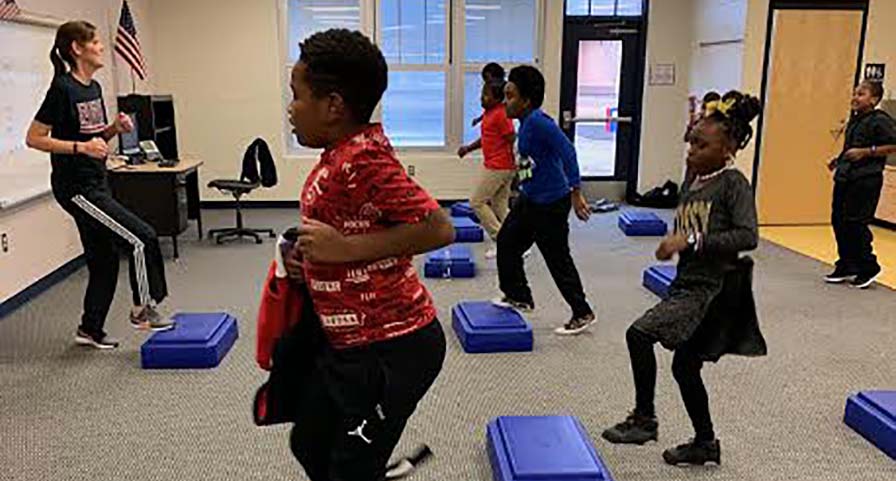Students Take First Steps Toward Fitness Management After Teacher Begins New Semester With IHT ZONE Wrist Heart Rate Monitors
When Bridge Creek Elementary (Elgin, S.C.) became a medical magnet campus, Lindsay Belville enhanced her health and PE program by adding IHT ZONE wrist heart rate monitors to her curriculum.
Belville’s students (grades 2-5) first started using the ZONE monitors in January, and Belville’s seen them embrace the technology.
“They love it,” Belville said after her first week using the ZONEs. “They want to keep it on all day. They want to get the opportunity to get their heart rate up. They don’t want to be in the blue.”
Students wore the ZONE heart rate monitors during their step-aerobics class. The monitors showed them how hard their hearts worked based on the color display:
- Blue indicates low exertion
- Yellow indicates moderate exertion
- Red indicates vigorous exertion
Belville’s introductory lessons covered both the heart rate monitors themselves – how to put them on, how to activate them and how to read them – and how the heart functions during exercise. Her curriculum lays the groundwork – along with easy-to-understand feedback from the ZONE – for students to lead healthy, active lives later in life.
Medical Magnet School Makes Health a Priority
Though she’s still in the early stages with her students, Belville sees the ZONE as a key element of Bridge Creek’s new medically-focused curriculum.
“It is an essential skill knowing how to be physically healthy,” she said. “So getting a head start now at age 8-9-10 and understanding this is the first step in a lifelong process.”
Richland School District Two created a medical magnet program at four of its campuses by working with MedPro 21. Another elementary school, a middle school, and a high school join Bridge Creek to give students a continuing path designed to prepare them for health-based jobs in South Carolina.
 The curriculum adds a medical element to the traditional STEAM focus of science, technology, engineering, arts, and math. The new program aligns with state standards and core content in addition to the medical classes.
The curriculum adds a medical element to the traditional STEAM focus of science, technology, engineering, arts, and math. The new program aligns with state standards and core content in addition to the medical classes.
Belville used her portion of a school-wide MedPro 21 grant to purchase her heart rate monitors late in 2018. She chose IHT’s monitors after comparing several features with other monitors.
“I’ve been wanting to get heart rate monitors for our students, and I couldn’t find anything where they could check in and out quickly,” she said. “These [ZONE] monitors do that correctly.”
At the start of each class, students activate – pick up – the monitor by placing it on the Spirit classroom reader attached by USB to the teacher’s computer. The process takes just a few seconds for each student. At the end of the session, students use the same process to “return” the monitors. The heart rate data immediately transfers, and students can see on her computer screen if they met the day’s goal for minutes exercising in the target heart rate zone.
After she sees students during their week-long health rotations, Belville will use the ZONEs when students begin rotating through PE classes. In her health class, Belville teaches students about the heart’s functions and then gets students moving with a step aerobics program.
“You can get your heart rate up pretty high, pretty quickly,” Belville said. “Last semester, they could do their aerobics and they would know that they are exhausted. But now they’re putting that exhaustion together with what heart rate zone they’re in and correlating both feelings and reading together.”
By quickly embracing the ZONEs, students give Belville confidence that they will pick up the pace and regularly reach the goals she sets during class. While that’s one of her focal points, she’s also looking at the bigger picture.
Teaching Students Fitness Management Skills They Can Take Home
Belville wants her students to use the ZONE monitors to reinforce what they feel while exercising. By learning what vigorous exercise feels like, students will eventually be able to create a health-enhancing workout away from her watchful eyes.
 “Hopefully we’re teaching them things that they can take home with them and do outside of PE to make better life habits now,” she said.
“Hopefully we’re teaching them things that they can take home with them and do outside of PE to make better life habits now,” she said.
The teacher understands the constraints of her school’s schedule. Students have PE for a full week but just once every four weeks.
“So I see these kids for five days this week and I’ll get new kids next week,” she explains. “Eventually I’ll get that first group of kids back. That makes what they do at home just as important as what they do in PE. I can teach you about it [in class], but I can’t do enough in 50 minutes to benefit them for an entire week.”
That’s part of preparing students – even as young as second grade – for life after school. The sooner they master fitness skills, the more likely they are to utilize them as adults.
“They’ll eventually be 18 years old and graduating from high school and hopefully progressing through college and out into the real world,” Belville said. “They’ll still need to know this.
“I mean, this is an essential skill, right? I think it’s important that they understand their own body and what they can do to change that and to become healthier now and that they don’t have to wait.”
Seeking IHT Spirit System information?



